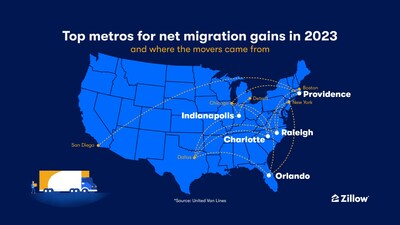Interstate movers chased affordability in 2023
People relocated to metros
Charlotte ,Providence andIndianapolis saw the highest net in-migration among the 50 largest markets.Chicago ,San Diego andCincinnati witnessed the most outbound moves compared to inbound relocations.- Record-high housing costs in 2023 likely drove the continued trend of moving toward affordability.
- Movers are also, increasingly, relocating to areas with more home listings per resident.
The five metro areas that saw the largest net migration gains according to the United Van Lines data were relatively affordable markets in the South, Midwest and Northeast. Although housing affordability has always played a key role in explaining migration patterns, the increase in house prices during the pandemic and the subsequent jump in mortgage rates appears to have intensified the search for more tolerable monthly payments.
"Affordability is one of the biggest considerations for home buyers and sellers, and clearly plays a major role in deciding where to put down roots," said Zillow Senior Economist Orphe Divounguy. "Housing costs hit record highs last year, and made both buying and selling difficult, even for homeowners sitting on massive equity. Finding a less expensive area where dollars aren't quite so stretched was a smart move for a lot of people."
Affordability may improve slightly in 2024, but it has declined significantly over the past four years. The share of median household income needed to pay rent has risen from less than
United Van Lines customers have higher average household incomes than movers overall, but migration flows in the
Among the 50 largest metros by population, those with the highest net in-migration from United Van Lines customers in 2023 were
Of those five metros, four ranked among Zillow's 10 hottest markets of 2024. This index is driven by expected home value growth, how fast home sellers are entering into contracts with buyers, job growth per new home permitted and growth in owner-occupied households.
Metros with the highest net number of residents relocating were
United Van Lines customers are also, increasingly, moving to markets with less potential competition for homes. Movers relocated to destination metros with an average of six fewer competitors per listing in 2019. That difference grew to 13 in 2023.
Metros with more United Van Lines outbound moves than inbound moves tended to experience less growth in their working-age population in the same year, and lower growth in home values in the year that immediately followed.
Year | Average | Average | Average Metro- | Average | Average | Difference |
2018 | - | 203 | 209 | -6 | ||
2019 | - | 205 | 210 | -6 | ||
2021 | - | 333 | 342 | -9 | ||
2022 | - | 319 | 328 | -9 | ||
2023 | - | 377 | 390 | -13 |
Source: United Van Lines and Zillow data |
* Metropolitan Statistical Area (MSA) |
About Zillow Group
Zillow Group, Inc. (NASDAQ: Z and ZG) is reimagining real estate to make home a reality for more and more people. As the most visited real estate website in
Zillow Group's affiliates, subsidiaries and brands include Zillow®, Zillow Premier Agent®, Zillow Home Loans℠, Trulia®, Out East®, StreetEasy®, HotPads®, ShowingTime+℠, and Spruce®.
All marks herein are owned by MFTB Holdco, Inc., a Zillow affiliate. Zillow Home Loans, LLC is an Equal Housing Lender, NMLS #10287 (www.nmlsconsumeraccess.org). © 2023 MFTB Holdco, Inc., a Zillow affiliate.
About United Van Lines
United Van Lines is America's #1 Mover®. United Van Lines offers a full range of moving solutions. With headquarters in suburban
![]() View original content to download multimedia:https://www.prnewswire.com/news-releases/interstate-movers-chased-affordability-in-2023-302029385.html
View original content to download multimedia:https://www.prnewswire.com/news-releases/interstate-movers-chased-affordability-in-2023-302029385.html
SOURCE Zillow









